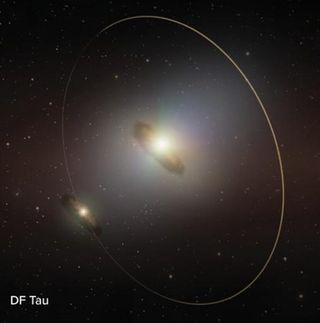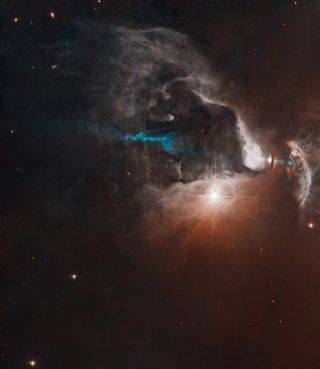Astronomers have gained new insights into the formation of planets around twin stars that orbit each other.
Although we are most familiar with planets orbiting a single, central star – such as the arrangement of our solar system – over 50% of the stars in the cosmos exist in a binary star system, that is, they have a companion star. These binary star systems can also be surrounded by planets that either orbit one of the stars in a “circumstellar orbit” or orbit both stars in a much larger “circumbinary orbit.”
Using the Atacama Large Millimeter/submillimeter Array (ALMA) – consisting of 66 radio telescopes in northern Chile – and the 10-meter Keck II telescope in Hawaii, astronomers collected data from two twin star systems. Their results could change our understanding of the conditions that can promote or prevent such planet formation in binary star systems.
Related: Like in the 90s, double stars are back in fashion
Are two stars better than one for planet birth?
The formation of binary stars is not much different from the formation of single stars. These bodies form when dense clouds of cool interstellar gas form excessively dense patches that accumulate more mass and eventually collapse under their own gravity, creating a stellar child called a “protostar.”
This protostar continues to collect material from its prenatal cocoon of gas and dust until it has enough mass to trigger nuclear fusion of hydrogen into helium at its core, the process that defines a main sequence star. Importantly, some of these interstellar clouds are large enough to allow the formation of two or even three main sequence stars within them.
The material that remains from this cloud of gas and dust after these stars form surrounds them in what astronomers call a “protoplanetary disk.” As the name suggests, planets form from these disks. Like the planets themselves, the disks can be circumstellar, surrounding just one star, or circumbinary, surrounding the entire system.
Scientists currently don’t know what factors cause these disks to persist long enough to form planets, nor are they sure what ultimately causes the disks to break up. As it turns out, circumstellar disks in binary star systems in front of main-sequence protostars may be the ideal laboratories to study these questions.
Properties of these early disks, such as their size, substructure, and even their inclination (relative to protostar properties such as rotational speed and magnetic field strength) can reveal details of the complex interactions that shape such planet-birth environments.
Furthermore, due to the ubiquity of multiple star systems in the universe, studying planet formation around twin stars is crucial to further understanding this process.

One of the binary star systems the team focused on with ALMA and Keck II was DF Tau. It consists of two protostars with about 0.6 times the mass of the Sun and is located about 150 light-years from Earth in the star-forming region of the constellation Taurus.
The two stars of DF Tau are separated by a distance that is about 14 times the distance between the Earth and the Sun. They take about 44 Earth years to complete their greatly elongated orbits.
Intriguingly, ALMA discovered that the interstellar cloud responsible for the formation of these stars has split into two circumstellar disks. One is magnetically bound to the central star, DF Tau A, and is actively feeding it with material to fuel its growth. The other appears to have broken away from the other star, DF Tau B. The central region of the disk appears to have eroded as the young star spins rapidly.
This suggested to the team that there might be a connection between the rotation of young stars and the magnetic binding of disks to them, and hence the early dissolution of the disks. Furthermore, it seems that misalignments between the orbit of DF Tau, its circumstellar disks and the inclinations of its stars could affect the overall evolution of the disk.

The second binary star system the team focused on was the very young, 2.8 million year old FO Tau system (for comparison, the solar system is 4.6 billion Year old).
This system is also about 450 light years away from us. Its stars, FO Tau A and B, are in a more circular orbit than DF Tau’s. They are also farther apart, with FO Tau B orbiting FO Tau A at a distance about 22 times the distance between the Earth and the Sun.
Using ALMA, the astronomers found that FO Tau’s disks are aligned with the orbit of this binary star. Both stars have rather slow rotation speeds, and the two circumstellar disks remain magnetically bound to their protostars. This suggests that systems like FO Tau with slower stars and more circular orbits may be better suited to the formation of planetary bodies around both component stars than fast systems with elongated orbits.
ALMA observations of other single and double star disks have revealed complex substructures within the disks, including features such as spiral patterns, gaps, and ring formations.
Although these structures are currently not visible for DF Tau and FO Tau, determining the larger-scale properties in these two close binary systems has significantly advanced our understanding of the planet formation environments.
The team’s results were announced at the 244th meeting of the American Astronomical Society (AAS).